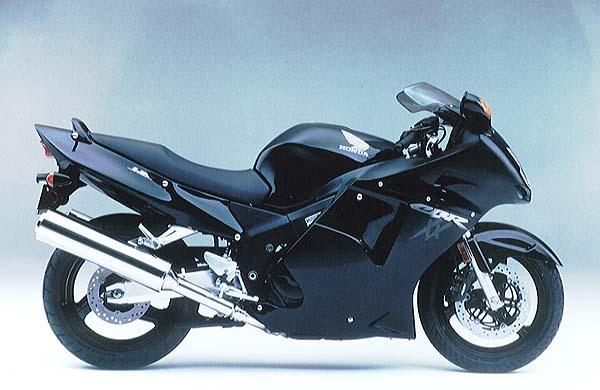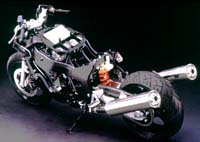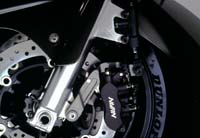

It cannot be much better than this at the time being. Read the full story about the Honda CBR1100XX Super Blackbird at Bikenet. You can even go here.


It cannot be much better than this at the time being. Read the full story about the Honda
CBR1100XX Super Blackbird at Bikenet.
You can even go here.
Key features of the bike include:
By Tom Fortune, Managing Editor
Photos Courtesy American Honda
On Thursday July 4th, Honda assembled the European motorcycling press in Frankfurt, Germany, and announced the arrival of the highly anticipated CBR1100XX Super Blackbird. Applying lessons learned during the development of their other two best-selling sporting machines, the CBR900RR and CBR600F3, Honda set out to develop an open-class motorcycle whose emphasis is not just on delivering the highest power output or fastest top speed at the expense of other factors, but to combine several high-performance features with a level of riding comfort never before realized in the big-bore sport class. Honda wants the Blackbird -- their first new liter-plus sportbike in several years -- to be identified as The World's Greatest Super Sport.
Bikes like these have a history of being reserved for the European market, much to the chagrin of American sportbike riders. The good news is that Honda will be bringing the new CBR to the U.S. for 1997 - sans the Super Blackbird moniker - and is scheduled to formally announce the bike at the Honda Dealer Convention in Nashville, Tennessee in October.
Styled like no other Honda sportbike before it, the new CBR1100XX incorporates what Honda refers to as the ultimate in wind tunnel-tested construction to achieve a small frontal area and one of the lowest effective coefficients of drag in motorcycling, while maintaining a high level of wind protection and rider comfort. Striking in its appearance, the fairing features a narrow frontal aspect, equal to that of a 50cc motorcycle, allowing smooth air flow with minimal resistance. Honda claims the fairing draws in just enough air around the front wheel and fender to provide effective cooling to the radiator, while still realizing a frontal area effectively smaller than most 250cc racer replicas. Excellent aerodynamics, rather than looks, were a top priority in the new fairing's design. The unusual over-under, dual "piggy-back" headlights and the bullet-shaped upper nose fairing, incorporating mirror-integrated turn signals, are certain to produce some strong opinions about its styling.
The CBR1100XX's all-new, lightweight 1,137cc engine features the same crankcase and cylinder block arrangement used in both the CBR600 and CBR900. The cylinders are canted forward 22 degrees more than those on the CBR1000F, with the cams driven by a side-mounted chain. Valve actuation is via direct cam-over-bucket configuration with a 30 degree included valve angle, 2 degrees less than the CBR900RR layout, resulting in a more compact combustion chamber shape.
 The design team concentrated on keeping the new engine small and
light, and despite being nearly 140cc more than the CBR1000's mill, and featuring an
all-new dual-shaft balancer system to boot, the new engine weighs fully 22 pounds less
than the 998cc powerplant. Following Honda's optimal mass centralization approach used on
the redesigned CBR900RR, the 1100XX's small engine package permits it to be positioned in
the ideal location in the frame for ultra-light handling.
The design team concentrated on keeping the new engine small and
light, and despite being nearly 140cc more than the CBR1000's mill, and featuring an
all-new dual-shaft balancer system to boot, the new engine weighs fully 22 pounds less
than the 998cc powerplant. Following Honda's optimal mass centralization approach used on
the redesigned CBR900RR, the 1100XX's small engine package permits it to be positioned in
the ideal location in the frame for ultra-light handling.
Previously, no motorcycle engine powering a high-performance sportbike has ever used a dual-shaft balancer in its design. Not unusual in the automotive world, it has been used in a couple of touring bikes in the past. Honda claims the new dual-shaft balancer design featured in the XX almost completely eliminates high-frequency vibration. The first balancer shaft is located in front of the crankshaft, spinning in the opposite direction of the crank, while the second balancer shaft is located above and behind the crankshaft, spinning in the same direction as the crank, the combination of the two shafts supposedly eliminating the effects of secondary vibration.
Other features found on the new 1100's engine include an ignition system that is of the same 3-D map-type digital design used on the '96 CBR900RR. The four 42mm slanted flat-slide CV carbs are also similar to those used on the 900RR, and feature a throttle position sensor linked to the ignition system. Because of the room required to fit the twin balancer shafts in the crankcase, a new compact ACG was positioned on the left end of the crankshaft. On the other side, the hydraulic clutch utilizes nine 150mm plates covered by a floating clutch cover using a thick rubber gasket and rubber inserts around its mounting bolts to minimize mechanical noise from the clutch area. And a large-capacity oil cooler is mounted directly beneath the steering head, receiving a steady stream of cooling air from the twin air intake ports in the nose of the fairing.
 Honda engineers fitted the CBR-XX with a dual-spar
diamond-configuration aluminum frame similar in design to the new frame found on this
year's CBR900RR. The new frame features large triple-box-section extruded main spars
welded to rigid cast-aluminum swingarm pivot plates and a cast-aluminum steering head. The
frame's bolt-on seat rail is made from box-section mild steel tubing. A new
triple-box-section extruded aluminum swingarm is fitted, and is supported by one of
Honda's latest internal-piston shocks which offers stepless-adjustable rebound damping and
4.7 inches of travel. No compression damping adjustment is offered. Up front, a pair of
conventional slider 43mm cartridge forks feature Honda's Multi-Action System (H.M.A.S.)
internal piston design, and have 4.3 inches of travel. In a surprising move, there are no
suspension adjustments offered on the CBR-XX's forks.
Honda engineers fitted the CBR-XX with a dual-spar
diamond-configuration aluminum frame similar in design to the new frame found on this
year's CBR900RR. The new frame features large triple-box-section extruded main spars
welded to rigid cast-aluminum swingarm pivot plates and a cast-aluminum steering head. The
frame's bolt-on seat rail is made from box-section mild steel tubing. A new
triple-box-section extruded aluminum swingarm is fitted, and is supported by one of
Honda's latest internal-piston shocks which offers stepless-adjustable rebound damping and
4.7 inches of travel. No compression damping adjustment is offered. Up front, a pair of
conventional slider 43mm cartridge forks feature Honda's Multi-Action System (H.M.A.S.)
internal piston design, and have 4.3 inches of travel. In a surprising move, there are no
suspension adjustments offered on the CBR-XX's forks.
 Honda equipped the big Super Sport with an evolutionary version of
the Linked Braking System (LBS) found on the '96 ST1100 ABSII. The CBR-XX's system is
tuned more for the braking requirements of a high-performance sportbike, rather than the
more comfort-oriented requirements of the sport touring ST. The system features a new
delay valve, located between the foot pedal's master cylinder and the center pistons of
the front brake calipers, that is supposed to smooth front brake engagement and minimize
brake dive associated with sudden application of the front brakes. All-new, thinner 310mm
floating front discs feature new stainless steel mounting carriers that use a simpler
spoke design than the aluminum units used on most of Honda's current big-bore sportbikes.
The number of floating disc inserts was also reduced from twelve to six. The rear disc is
a standard one-piece 256mm unit.
Honda equipped the big Super Sport with an evolutionary version of
the Linked Braking System (LBS) found on the '96 ST1100 ABSII. The CBR-XX's system is
tuned more for the braking requirements of a high-performance sportbike, rather than the
more comfort-oriented requirements of the sport touring ST. The system features a new
delay valve, located between the foot pedal's master cylinder and the center pistons of
the front brake calipers, that is supposed to smooth front brake engagement and minimize
brake dive associated with sudden application of the front brakes. All-new, thinner 310mm
floating front discs feature new stainless steel mounting carriers that use a simpler
spoke design than the aluminum units used on most of Honda's current big-bore sportbikes.
The number of floating disc inserts was also reduced from twelve to six. The rear disc is
a standard one-piece 256mm unit.
Other features of Honda's newest super sportbike include newly developed Mono-spiral, Z-rated radial tires created specially for the XX that will be supplied by three OEM makers: Michelin, Dunlop, and Bridgestone. The XX will be equipped with a large 5.8 gallon fuel tank that should ensure good sports touring range, and the 4-2-1-2 exhaust system will feature large-capacity, stainless steel canister-style mufflers.
If you understand Danish you can also read this: 1 and 2
Engine Liquid-cooled 4-stroke 16 valve DOHC inline 4
Bore x Stroke 79 x 58mm
Displacement 1,137cc
Compression ratio 11:1
Carbs 42mm slanted flat-slide CV x 4
Max. Power 164PS/10,000rpm
Max. Torque 12.7kg-m/7,250rpm
Ignition Computer-controlled digital transistorised with
electronic advance
Starter Electric
Transmission 6-speed
Final Drive 'O'-ring sealed chain
Dimensions (LxWxH) 2,160x720x1,170mm
Wheelbase 1,490mm
Seat Height 810mm
Ground Clearance 130mm
Fuel Capacity 22 litres
Wheels Hollow-section triple-spoke cast
Tyres Front 120/70 ZR17 Radial
Rear 180/55 ZR17 Radial
Suspension Front 43mm Cartridge-type fork, 120mm travel
Rear Pro-link with gas-charged damper, rebound
adjustable 120mm travel
Brakes Front 310mm dual disks with "dual
combined" three-piston calipers
Rear 256mm single disk with three-piston
caliper
Dry weight 223kg
Colours Titanium Metallic, Mute Black Metallic,
Candy Muthos Magenta
Some of the best pictures are also available here:
Pictures "borrowed" from Bikenet.
(Click on the small pictures to download a larger one)